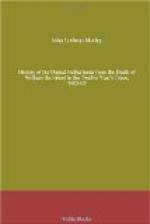But national instinct is often wiser than what is supposed to be high national statesmanship, and there can be no doubt that the true foundation of the East India Company was the simple recognition of an iron necessity. Every merchant in Holland knew full well that the Portuguese and Spaniards could never be driven out of their commercial strongholds under the equator, except by a concentration of the private strength and wealth, of the mercantile community. The Government had enough on its hands in disputing, inch by inch, at so prodigious an expenditure of blood and treasure, the meagre territory with which nature had endowed the little commonwealth. Private organisation, self-help; union of individual purses and individual brains, were to conquer an empire at the antipodes if it were to be won at all. By so doing, the wealth of the nation and its power to maintain the great conflict with the spirit of the past might be indefinitely increased, and the resources of Spanish despotism proportionally diminished. It was not to be expected of Jacob Heemskerk, Wolfert Hermann, or Joris van Spilberg, indomitable skippers though they were, that each, acting on his own responsibility or on that of his supercargo, would succeed every day in conquering a whole Spanish fleet and dividing a million or two of prize-money among a few dozen sailors. Better things even than this might be done by wholesome and practical concentration on a more extended scale.
So the States-General granted a patent or charter to one great company with what, for the time, was an enormous paid-up capital, in order that the India trade might be made secure and the Spaniards steadily confronted in what they had considered their most impregnable possessions. All former trading companies were invited to merge themselves in the Universal East India Company, which, for twenty-one years, should alone have the right to trade to the east of the Cape of Good Hope and to sail through the Straits of Magellan.
The charter had been signed on 20th March, 1602, and was mainly to the following effect.
The company was to pay twenty-five thousand florins to the States-General for its privilege. The whole capital was to be six million six hundred thousand florins. The chamber of Amsterdam was to have one half of the whole interest, the chamber of Zeeland one fourth; the chambers of the Meuse, namely, Delft, Rotterdam, and the north quarter; that is to say, Hoorn and Enkhuizen, each a sixteenth. All the chambers were to be governed by the directors then serving, who however were to be allowed to die out, down to the number of twenty for Amsterdam, twelve for Zeeland, and seven for each of the other chambers. To fill a vacancy occurring among the directors, the remaining members of the board were to nominate three candidates, from whom the estates of the province should choose one. Each director was obliged, to have an interest in the company amounting to at




